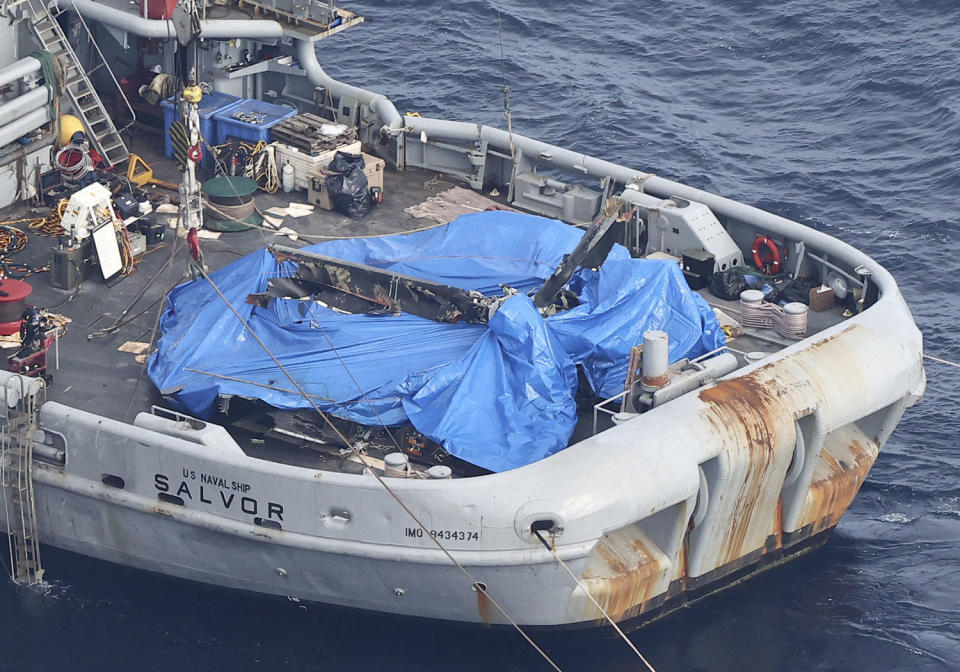Investigators are looking at the gearbox in deadly U.S. Air Force Osprey crash
The investigation into yet another deadly crash of a U.S. military Osprey aircraft in late November is looking at a possible mishap involving the aircraft’s propeller rotor gear box, U.S. officials familiar with the preliminary findings say.
The accident, in which a U.S. Air Force V-22 Osprey crashed into the ocean off Japan, killing eight airmen, was the fourth fatal crash of the unique tiltrotor aircraft in less than two years. Twenty U.S. service members have died in the incidents, leading to a rare grounding in December of all Osprey aircraft by all branches of the U.S. military.
The cause of the crash off Japan is still under investigation and has not been established, according to those familiar with the investigation.
In a statement after initial publication of this article, a spokesperson for Air Force Special Operations Command told NBC News that investigations into the incident "are still actively in progress and analysis is ongoing to determine the cause of the mishap. At this time, the material failure that occurred is known but the cause of the failure has not been determined. ... Any disclosure of findings prior to investigations being finalized is premature and presumptive."
Ospreys can take off vertically like helicopters, but then tilt their two rotors to fly like dual propeller planes. The military has about 400 Ospreys that are used by the Navy, Marines and Air Force, though most are flown by the Marine Corps.

In the past the Ospreys sometimes had a problem called a "hard clutch engagement," which in one June 2022 incident caused a crash that killed five Marines. In February 2023 the military said while they had still not determined a root cause for the hard clutch incidents, officials were 99% sure the clutch problem was fixed. The military’s joint program office for the aircraft told NBC News that the last of the 19 hard clutch engagements reported by all three service branches occurred in January 2023.
The Pentagon’s joint program office said in a statement that military leaders are working to provide service members “with the safest, most reliable aircraft possible. … The safety and well-being of our personnel and the reliability of the V-22 continues to be a priority in our discussions as we determine our return to flight plan.”
While it was first believed that the Osprey grounding could last as long as a year, it’s now expected that the aircraft may return to flight soon, possibly within weeks, according to multiple military officials.
Metal chips in the gear boxes
An NBC News review of Osprey mishap and hazard data from the Navy and Marines, however, shows other incidents involving the propeller rotor gear boxes. Since July 2022, there have been at least seven instances of metal chips found in the gear boxes, though no fatalities have resulted.
“One would hope that that’s being examined really hard,” said retired military crash investigator Tom Farrier. “The question that it raises to me is — is there a linkage between the chip detections and the problems with the clutch? That’s where I would expect the Marines and the Navy to be expending a lot of resources for study.”
Each of the twin rotors has its own gear box. The gear box is as large as a motorcycle and serves a function similar to a car’s transmission. The box has magnets inside it that detect loose metal chips as small as a fingernail. Once they are detected, a warning indication is sent to the pilot, according to aviation experts.
Marine pilots are instructed that at the first indication of a metal chip in the gear box they need to land as soon as feasible, according to the pocket checklist for pilots. If there is a secondary indication of a metal chip, then pilots are instructed to land immediately no matter where they are, according to the checklist and incident reports.
One hazard report from Oct. 5, 2022 in Hawaii where chips were found in a Marine Osprey gearbox noted, “This event is further evidence that [Osprey] gearboxes are not performing to service life expectations and that more needs to be done to understand why [Osprey] proprotor gearboxes are experiencing chips.”
In another hazard report from Hawaii in June 2023, Marine records show that a warning light came on in an Osprey cockpit twice for chips in the prop rotor gear box “in rapid succession.” The report says the aircraft was shut down and chips were discovered in the gear box. The report notes, “No clear reason why chips occur other than old gearboxes.”
Five months later, another Marine report from Hawaii shows that a chip warning light came on while the aircraft was between the islands of Maui and Lanai. There was no secondary indication of a metal chip so the Osprey continued to Maui and landed. After some maintenance, the aircraft was “sent back up for a confidence flight” and the metal chip light came on again. After this, the entire gearbox was “deemed bad,” requiring replacement, according to the Marine data.
The report’s narrative notes, “V-22 [prop rotor gear boxes] are known to chip out but there is not a standard reason for why or how often. By submitting these reports we can track frequency of events.”
One prop rotor gear box chip incident in a Marine aircraft from November 2022 is still under investigation, according to the data.
Detailed mishap data from the Air Force was not available in time for publication.
This article was originally published on NBCNews.com

